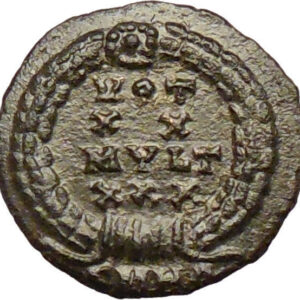|
Carus – Roman Emperor: 282-283 A.D.
Divus Carus Issue
Bronze Antoninianus 20mm (4.4 grams) Struck under Carinus. Antioch mint, struck May-June 284 A.D.
Reference: RIC 127
DIVO CARO AVG, radiate head right.
CONSECRATIO, garlanded altar; Δ in right field, XXI in exergue.
You are bidding on the exact item pictured, provided with a Certificate of Authenticity and Lifetime Guarantee of Authenticity.
Consecration Ceremony in Ancient Rome
 The ceremony of consecration was very solemn and imposing. After the body had been clothed in the habiliments of death, it was placed on a bed of ivory; young men, chosen from the equestrian order, bore it on their shoulders to the pile. The ceremony of consecration was very solemn and imposing. After the body had been clothed in the habiliments of death, it was placed on a bed of ivory; young men, chosen from the equestrian order, bore it on their shoulders to the pile.
The Rogus, or Funeral Pile, is described by Dion, as “a structure in the form of a turret, with three stories, of ivory and gold, and ornamented with statues.” Herodian describes it as a mass of quadrangular shape, filled at the bottom with combustibles, on which again a second tier was placed of similar form and appearance, but narrower and furnished with openings; to this a third and a fourth were added, each gradually diminishing in size, till the whole resembled a watch-tower.”
The corpse being then introduced into the second layer or story, it was surrounded with aromatics and precious balms. The usual ceremonies being completed, a torch was applied, and the mass was consumed. After this apotheosis, the deceased emperor or empress had temples, altars, and priests dedicated to his or her honour, and the same worship was paid to the defunct, as paganism rendered to its gods and goddesses; whilst the Augusti, or Augustae, were thenceforth called DIVI and DIVAE. The form of the rogus, described as above by ancient writers, is brought to our view, with remarkable clearness, on numerous coins. “Amongst these,” adds Eckhel, “there is one which I am told, stands conspicuous. This is a Julia Maesa, discovered at Rome; respecting which its then possessor, Viscount Ennius, a renowned antiquary, wrote to Garampi, papal nuncio at Vienna, that it is so well executed, and in such high preservation, that in the second layer of the funeral pile, the corpse of the empress is seen recumbent on a bed; a minute particular, never before distinguished in the monetal representation of these funeral structures.”
Marcus Aurelius Carus (c. 230 – late July/early August, 283) was a Roman Emperor (282-283). During his short reign, Carus tried to follow the path of restoration of the empire strength marked by Aurelian and Probus. His sons Carinus and Numerian formed, with Carus, a short lived dynasty, which granted further stability to a resurgent empire. He also had a daughter Aurelia Paulina.
Biography
Carus, whose name before the accession may have been Marcus Numerius Carus, was born, probably, at Narbo (modern Narbonne) in Gaul,[1] but was educated at Rome. He was a senator, and had filled various civil and military posts before he was appointed prefect of the Praetorian Guard by the emperor Probus in 282. After the murder of Probus at Sirmium, Carus was proclaimed emperor by the soldiers. Although Carus severely avenged the death of Probus, he was himself suspected of having been an accessory to the deed. He does not seem to have returned to Rome after his accession, but contented himself with an announcement of the fact to the Senate.
Bestowing the title of Caesar upon his sons Carinus and Numerian, he left Carinus in charge of the western portion of the empire, and took Numerian with him on the expedition against the Persians which had been contemplated by Probus. Having defeated the Quadi and Sarmatians on the Danube, Carus proceeded through Thrace and Asia Minor, annexed Mesopotamia, pressed on to Seleucia and Ctesiphon, and carried his arms beyond the Tigris. The Sassanid Emperor Bahram II limited by internal opposition, could not effectively defend his territory. For his victories, which avenged all the previous defeats suffered by the Romans against the Sassanids, Carus received the title of Persicus Maximus.
Carus hopes of further conquest were cut short by his death. One day, after a violent storm, it was announced that he was dead. His death was variously attributed to disease, the effects of lightning, or a wound received in a campaign against the Persians. The facts that he was leading a victorious campaign, and that his son Numerian succeeded him without opposition, suggest that his death may have been due to natural causes.
|





 The ceremony of consecration was very solemn and imposing. After the body had been clothed in the habiliments of death, it was placed on a bed of ivory; young men, chosen from the equestrian order, bore it on their shoulders to the pile.
The ceremony of consecration was very solemn and imposing. After the body had been clothed in the habiliments of death, it was placed on a bed of ivory; young men, chosen from the equestrian order, bore it on their shoulders to the pile. 




